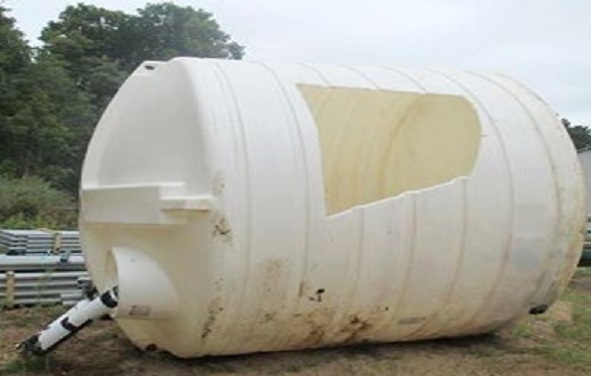(Image above: the hole cut into the side of the whey tank was used for the rescue operation)
Alright, let’s dive a little deeper into this. We’re going to talk about something that’s as serious as a heart attack, and it’s all about confined spaces on the farm. Now, I know what you’re thinking, “What’s the big deal about a little tight squeeze?” Well, let me tell you a story that’ll make your hair stand on end.
Picture this: A hard-working farm maintenance worker, just doing his job, enters an 8,000-gallon polyethylene storage tank. This tank, which was filled with liquid whey, wasn’t marked to indicate any potential hazards. But here’s the kicker: as whey decomposes, it produces carbon dioxide gas. And that’s not something you want to be breathing in.
Our guy was lowered into the tank through a 16-inch-diameter hole at the top to fix a broken ball valve. The forklift operator, who was his only connection to the outside world, had no way of seeing what was happening inside that 12-foot-by-12-foot tank. By the time the operator realized something was wrong, it was too late. Our worker had succumbed to asphyxiation.
Now, what went wrong here? The high outdoor temperatures and direct sunlight on the tank caused the whey to decompose faster than usual, releasing lethal carbon dioxide gas and lowering oxygen levels. The employer didn’t recognize the tank as a confined space with potential hazards, and there were no protective measures in place.
So, how do we prevent such tragedies? Here are some pointers:
- Identify and label all confined spaces. This includes grain and feed storage facilities, corrugated steel bins, silos, sumps, tunnels, pump pits, dump pits, forage storage, manure storage tanks, manure/bio-digester units, manure transport vehicles, bulk transport vehicles, sprayer and chemical transport vehicles, forage and silage dump wagons, feed grinders/mixers, feed mixer wagons tanks, storage and mixing tanks, bins, and silos, fermentation vessels, environmentally controlled fruit and vegetable storage units, bulk liquid storage tanks, containment areas around diked storage tanks, wells, cisterns, dry wells, septic tanks, grain driers, and fuel storage tanks.
- Evaluate all confined spaces for any actual or potential hazards. This is not just a one-time thing. Regular checks and evaluations are necessary to ensure that the conditions haven’t changed. Remember, safety is a continuous process, not a one-off event.
- Train your workers to never enter a confined space before the hazards and the steps to address them have been identified. This is crucial. Knowledge is power, and in this case, it could be the difference between life and death. Make sure your workers are well-informed and well-prepared.
- Consider chemical reactions that could occur based on the materials in the confined spaces, and potential byproducts that could create a hazardous atmosphere. This is where a little bit of science comes in handy. Understanding the properties of the materials you’re working with can help you anticipate potential dangers.
- Use a written confined space entry system that covers identifying hazards, testing and monitoring for oxygen content, flammability, toxicity, and explosion hazards, proper ventilation, maintaining contact with a trained attendant, and using appropriate equipment according to entry procedures. This is your game plan, your playbook. Make sure everyone knows it, understands it, and follows it.
- Develop an emergency action plan that includes quick removal of the entrant and procedures for facility operators and local responders. Because when things go wrong, every second counts. Having a well-thought-out plan can make all the difference.
Remember, folks, safety is not just a word, it’s a way of life. It’s about making sure we’re doing everything we can to keep our workers safe and sound. Because at the end of the day, we all want to go home to our families. So, let’s make sure we’re doing it right.
Now, let’s talk about workers’ rights. Every worker has the right to working conditions that do not pose a risk of serious harm. They have the right to receive information and training about workplace hazards, methods to prevent them, and the OSHA standards that apply to their workplace. They have the right to review records of work-related injuries and illnesses. They have the right to file a complaint asking OSHA to inspect their workplace if they believe there is a serious hazard or that their employer is not following OSHA’s rules. And they have the right to exercise their rights under the law without retaliation, including reporting an injury or raising health and safety concerns with their employer or OSHA.
Under the Occupational Safety and Health Act of 1970, employers are responsible for providing safe and healthful workplaces for their employees. OSHA’s role is to ensure these conditions for America’s working men and women by setting and enforcing standards, and providing training, education, and assistance.
In conclusion, confined spaces on the farm are not to be taken lightly. They pose serious risks and require careful management and adherence to safety protocols. By identifying and labeling confined spaces, evaluating them for hazards, training workers, considering potential chemical reactions, using a written confined space entry system, and developing an emergency action plan, we can help ensure the safety of our workers and prevent tragedies like the one I described earlier.
So, let’s make safety a priority. Let’s make sure we’re doing everything we can to keep our workers safe. Because at the end of the day, that’s what really matters. Stay safe out there, folks!
References:










